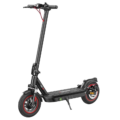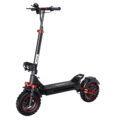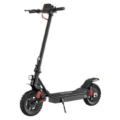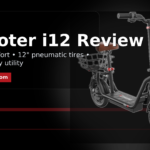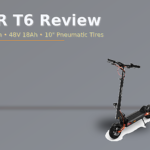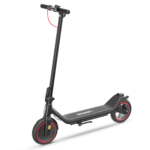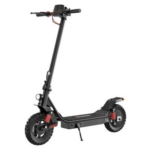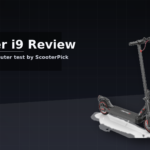- Home
- Scooters
- Electric Scooters
- iScooter X9
iScooter X9
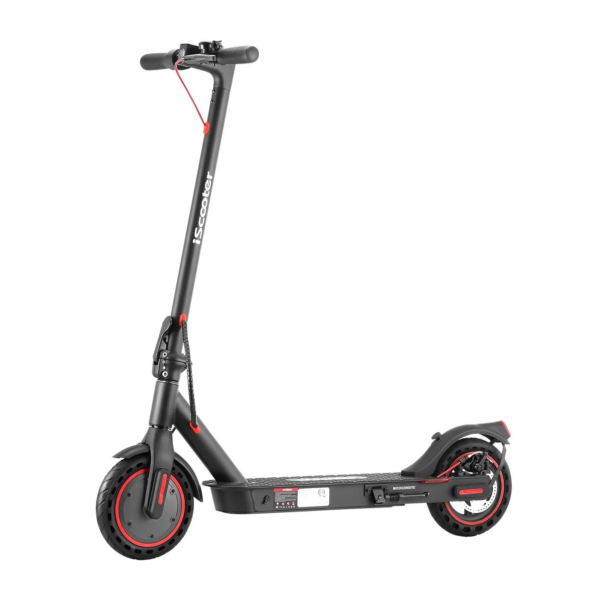

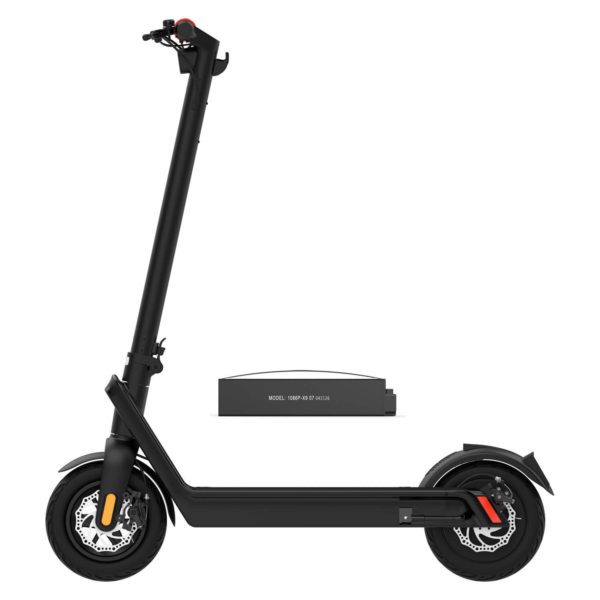

- Battery Range: 40–55 miles (64–88 km)
- Top Speed: 25 mph (40 km/h)
- Motor Power: 550 W rear hub
- Weight Capacity: 264 lb (120 kg)
- Charging Time: ~5–6 h (removable pack)
- Scooter Weight: 42.0 lb (19.0 kg)
PROS
- Removable 48V 15.6Ah battery
- Dual disc + E-ABS braking
- 10″ tubeless anti-puncture tires
- IP54 body rating
- Portable at ~42 lb
CONS
- No official app features
- No hydraulic brakes
- Turn signals not stated
Table of contents
- What Is the iScooter X9?
- How the iScooter X9 Works
- Key Specifications
- Design & Build Quality
- Performance Fundamentals
- Battery, Range & Efficiency
- Ride Quality & Comfort
- Braking & Safety Features
- Portability & Daily Usability
- Maintenance & Care
- Weather & Seasonal Considerations
- iScooter X9 vs Alternatives
- Who the iScooter X9 Is (and Isn’t) For
- FAQs
- Glossary
- Final Notes on Using the iScooter X9
The iScooter X9 is a stronger-than-average commuter scooter built for daily city travel and the occasional rough shortcut. It pairs a rear-hub motor rated up to 1000 W max with a 48 V, 14 Ah battery, 10-inch pneumatic tires, and dual suspension. As a result, the X9 suits riders who prioritize stable cruising, practical range, and real-world comfort over flashy numbers. If you’re cross-shopping, you can also consider the iScooter i10 Pro to compare size, range, and portability trade-offs.
Moreover, the chassis runs big wheels, dual mechanical discs, and electronic braking for predictable control. Meanwhile, the folding hardware and manageable weight make it realistic for home, office, or campus use.
What Is the iScooter X9?
The iScooter X9 is a full-size, single-motor adult e-scooter aimed at all-weather commuting and light off-road detours. It uses 10-inch off-road pneumatic tires, a rear-wheel drive hub motor (max 1000 W), and a 48 V, 14 Ah battery. In plain English, it’s a city-first scooter that doesn’t panic when the pavement ends for a block.
Additionally, it’s feature-rich for daily riding. You get dual mechanical disc brakes with electronic assist, front and rear suspension, front and rear LED lighting with a flashing brake light, turn signals, an LED dashboard, Bluetooth app control, and cruise control. Consequently, the frame folds in three steps and packs flat for a hallway, office corner, or trunk.
How the iScooter X9 Works
At its core, an electric scooter is a compact EV with a simple drivetrain. However, the details matter for daily reliability and control:
- Motor (rear hub): The X9 places a brushless DC motor inside the rear wheel. Because it’s hub-driven, there’s no chain or belt to maintain. Rear drive also helps traction during acceleration, especially on painted lines or damp patches.
- Controller: Think of the controller as the scooter’s brain. It meters battery current to the motor, obeys throttle commands, and enforces ride modes and top speed limits. In addition, it coordinates regenerative (electronic) braking.
- Battery: A 48 V, 14 Ah lithium-ion pack (about 672 Wh, since 48 V × 14 Ah ≈ 672 Wh) stores energy. Therefore, higher voltage helps keep current lower for the same power, which can improve efficiency and heat management.
- Throttle: The thumb throttle on the cockpit tells the controller how much power you want. Furthermore, if you hold a steady speed for several seconds, cruise control can take over to reduce thumb fatigue on longer paths.
- Brakes: Dual mechanical disc brakes provide primary stopping power. The controller also adds electronic (regen) braking to smooth deceleration and harvest a small bit of energy, especially at higher speeds.
Together, these systems create a ride that is easy to learn, simple to maintain, and confidence-inspiring in traffic.
Key Specifications
General
- Model: iScooter X9
- Intended use: Urban commuting with light off-road capability
- Maximum rider weight: 264 lb (120 kg)
- Water resistance: IPX4 (splash-resistant)
- Riding modes: Eco, Drive, Sport
- App connectivity: Bluetooth app for lock/unlock, cruise control, speed settings, and monitoring
- Display: LED dashboard (speed, battery, mode, lights, indicators, trip)
Performance & Power
- Top speed: Up to 28 mph (45 km/h)
- Motor: Rear hub, maximum power 1000 W (rear-wheel drive)
- Typical use case: City cruising; short, punchy climbs; multi-surface paths
- Claimed climbing angle: 25°
Battery, Charging & Electrical
- Battery: 48 V, 14 Ah lithium-ion (≈ 672 Wh)
- Claimed range: Up to 28 mi (45 km)
- Charging time: Approximately 6–8 hours
- Battery management: Smart BMS (battery health and protection)
- Cruise control: Yes (hold steady speed to engage)
Build & Dimensions
- Frame: Aluminum alloy
- Tires: 10-inch off-road pneumatic (air-filled)
- Suspension: Dual—front and rear
- Unfolded size: 45.7 × 25.2 × 52.2 in (115 × 60 × 128 cm)
- Folded size: 45.7 × 9 × 16.5 in (115 × 20 × 50 cm)
- Net weight: 48 lb (21.75 kg)
Safety & Control
- Brakes: Dual mechanical disc + electronic (regen) assist
- Lights: Front LED headlight, rear LED, flashing brake light
- Turn signals: Yes
- Reflectors: E-mark certified front, rear, and side reflectors
Features & Extras
- Folding mechanism: Easy 3-step fold
- Bell: Electronic horn
- App monitor: Yes (Bluetooth)
- Other: Ambient lighting, trip data on display
- Cruise Control: Included and configurable
Warranty & Compliance
- Warranty: 12-month limited warranty (scooter)
- Return window: 30 days (policy dependent)
- Ingress protection: IPX4 splash resistance
Design & Build Quality
The iScooter X9 looks and feels like a grown-up commuter. The aluminum frame and reinforced stem give it a sturdy stance without becoming unwieldy. Because the deck is long with a grippy surface, you can adopt a comfortable diagonal stance that opens your hips and lowers fatigue. Plus, the 10-inch pneumatic tires add a “big-wheel” look that also pays off in stability and rollover—curb cuts, pavers, and expansion joints feel less dramatic.
Up top, the cockpit is clean. You get a centered LED dashboard, a thumb throttle on the right, and brake levers left and right. Additionally, switchgear is simple, so you won’t hunt for controls while moving. The wiring runs tidy and protected, which helps durability if you commute daily.
Fit-and-finish matters for a scooter you’ll fold twice a day. Here, the hinge hardware clicks closed with a clear mechanical cue. Consequently, the folded package is long but flat, and it slides behind a desk or along a hallway wall without hogging space. Therefore, it works well for small apartments or shared offices.
Performance Fundamentals
Acceleration: With a rear-hub motor rated up to 1000 W max, the iScooter X9 steps off briskly in Sport mode. Throttle mapping is progressive, so starts feel controlled rather than jerky. Moreover, because drive is at the rear, traction stays predictable when crossing painted lines or light gravel.
Cruising stability: The chassis feels composed in the 15–22 mph (24–35 km/h) range most commuters use. Big tires help damp small ripples and expand the contact patch, and the dual suspension takes the sting out of broken pavement. Additionally, tire pressure matters. Keep pressures within the recommended range to balance suppleness and stability.
Hill behavior: On rolling neighborhoods with grades around 7–10%, the X9 holds pace best in Sport mode. You’ll feel speed drop on the longest climbs—that’s normal for single-motor scooters. Even so, the rear-drive layout continues to find grip, which helps you stay smooth on grippy and semi-loose surfaces alike.
Mode use: Eco is conservative for boardwalks and crowded multi-use paths. Drive suits most commutes. Sport is best for overtakes, short hills, and open bike lanes. Furthermore, switching modes mid-ride is straightforward, and cruise control reduces thumb fatigue on longer straights.
Battery, Range & Efficiency
The battery is a 48 V, 14 Ah pack—about 672 Wh of energy (48 V × 14 Ah). That’s healthy for a single-motor scooter and a good match for 10-inch tires and dual suspension. Consequently, the X9 delivers dependable energy availability across typical commute speeds.
Rated vs. real-world range: The official figure is up to 28 mi (45 km). Real-world results depend on rider weight, average speed, elevation gain, ambient temperature, and tire pressure. Therefore, expect shorter range if you’re heavier, ride fast, or climb often. Conversely, steady 12–15 mph (19–24 km/h) cruising on flat ground stretches range noticeably.
Rider weight & terrain: Riders near the 200–240 lb (91–109 kg) mark will see a bigger range delta on hilly routes. Rolling terrain pulls more current, and the pack drains faster. Nevertheless, because the X9 recovers a touch of energy under electronic braking, gentle route planning (and looking ahead) can help efficiency.
Temperature: Lithium-ion batteries deliver less energy when cold. In winter, plan for a tighter cushion. In summer, avoid leaving the scooter in a closed car, and allow the pack to cool before charging after a hot ride. As a result, you protect both the cells and the charger.
Charging best practices:
- Let the pack cool to room temperature before charging.
- Use the supplied charger and avoid extension cords when possible.
- Unplug after the indicator turns green.
- Store around 50–70% if you won’t ride for several weeks.
- Top up monthly during long storage.
Overall, these habits support battery longevity and keep performance consistent year-round.
Ride Quality & Comfort
Tires: The 10-inch off-road pneumatic tires define the X9’s feel. They smooth chatter, increase grip on varied surfaces, and build confidence on scarred asphalt. Because they’re air-filled, they do require pressure checks; however, the payoff in comfort and traction is worth the minute with a gauge.
Suspension: Dual suspension (front and rear) softens sharper hits and keeps the deck calmer at commuting speeds. You still feel the road—this is a scooter, not a motorcycle—but your hands, knees, and lower back will thank you on longer rides. Moreover, the setup reduces fatigue over uneven routes.
Ergonomics: The deck length supports a staggered stance with good knee bend. Bar height is comfortable for most adults, and the stem’s stiffness is appropriate for the class. Furthermore, if you load a backpack or carry groceries, stance width and bar control still feel secure.
Stem flex: With any folding scooter, clamp tightness matters. Check the latch weekly and wipe the mating surfaces clean. Done right, the X9 tracks straight, brakes predictably, and resists wobble when you look ahead and ride relaxed. Consequently, confidence grows with miles.
Braking & Safety Features
Braking system: The X9 uses dual mechanical disc brakes plus electronic (regen) assist. Lever feel firms up in the first half of the pull, and regen blends in to settle the chassis. On steeper downhills, use both levers evenly and look ahead to brake earlier and more smoothly. Therefore, stops become consistent and controlled.
Lighting: You get a bright front LED for visibility and a rear LED that flashes under braking. Turn signals add clarity at multi-use path junctions, especially at dusk. In addition, reflectors are E-marked front, rear, and sides, so the scooter stays conspicuous under street lighting.
Water resistance: The IPX4 rating means splash resistance from any direction. In short, it’s fine for damp roads and light showers, but you should avoid heavy rain, standing water, and washdowns. Consequently, you preserve bearings, connectors, and finish.
Control software: Cruise control helps on longer flats, but remember to cancel it with the brake or throttle when traffic thickens. Similarly, modes can cap speed for path etiquette. Use them deliberately to match conditions.
Portability & Daily Usability
Fold and carry: The X9 folds in three steps and locks compactly. At 48 lb (21.75 kg), it’s not ultralight; nevertheless, the mass feels balanced at the carry point. Short staircases are manageable; long hauls, however, are where an elevator earns its keep.
Storage: The flat folded profile tucks under a desk or along a hallway baseboard. At home, store on the main floor if you can—fewer stairs and a more consistent temperature. As a result, components last longer.
Security habits: Because a scooter is easy to lift, treat security seriously. Use a quality U-lock through the frame if possible, and add a steel cable for the front wheel. At work, combine physical locking with the app lock and keep it in a visible, well-trafficked area. In practice, layered security deters quick grabs.
Everyday workflow: Inflate tires to spec on Sunday night, charge to 80–100% depending on Monday’s plan, and wipe the deck and bars if it rained the day before. Consequently, the scooter stays predictable all week.
Maintenance & Care
A small routine goes a long way with the iScooter X9. Accordingly, use this simple schedule.
Before each ride (30–60 seconds)
- Check tire pressure with a gauge.
- Squeeze both brake levers to confirm firm feel.
- Ensure the stem latch is fully closed.
- Glance at the battery level and lights.
Weekly (10 minutes)
- Inspect tires for embedded debris and sidewall cuts.
- Wipe brake rotors with a clean, dry cloth.
- Check rotor alignment if you hear rubbing; adjust caliper position as needed.
- Inspect the deck, fenders, and cable runs for looseness or chafe.
Monthly (15–20 minutes)
- Verify all fasteners at the stem, bar clamp, calipers, and fenders are snug (do not overtighten).
- Review app settings; recalibrate display distance if needed.
- Clean the frame with a damp cloth—no hose or pressure washer.
Seasonal
- Rotate or replace tires if center tread flattens or punctures accumulate.
- Evaluate brake pads and cables for wear; replace when lever travel increases or stopping distance grows.
- Update firmware in the app only when release notes clearly apply to you. Otherwise, keep a stable build.
By following this cadence, you keep braking crisp, range consistent, and noises away.
Weather & Seasonal Considerations
Rain: IPX4 covers splashes and light rain. Slow down, brake earlier, and avoid painted symbols or steel plates. After wet rides, dry the scooter and stand it upright to let water drip away from electronics. Importantly, do not spray the scooter to clean it.
Cold: Below ~50 °F (10 °C), expect reduced range and slightly softer acceleration. Keep the scooter and battery warm indoors until just before your ride. After a cold commute, let the battery warm back to room temperature before charging. Consequently, the cells accept charge more evenly.
Heat: Above ~86 °F (30 °C), avoid leaving the X9 in direct sun for long periods. If the deck feels hot after a fast run, park in shade and allow a cool-down before charging. In turn, you reduce thermal stress.
Wind: Headwinds affect range more than most riders expect. When it’s gusty, plan a buffer. Because the X9 has good mid-range power, it holds speed better than entry-level scooters; nevertheless, steady winds still tax the pack.
Overall, a few adjustments per season keep the scooter predictable and safe.
iScooter X9 vs Alternatives
Compared with lighter commuter scooters: The iScooter X9 is heavier but feels substantially more planted. It accelerates harder, rides smoother on broken surfaces, and stops shorter thanks to dual discs. If you carry upstairs daily, a lighter option may be simpler; otherwise, the X9’s comfort wins most commutes. Therefore, choose based on your stairs and your streets.
Compared with performance scooters: True performance models go faster and climb steeper grades, often with dual motors and larger batteries. However, they weigh a lot more and cost you in portability. The X9 hits a sweet spot for riders who want real power without lugging a mini-moto.
Compared with off-road specialty models: Dedicated off-road scooters run knobbier tires and huge suspension travel. They’re fun on trails but awkward in city living. Instead, the X9’s off-road-ish tires and dual suspension deliver enough cushion for rough paths while staying friendly to daily routines.
In short: The iScooter X9 excels when you want a comfortable, fast-enough commuter that shrugs off imperfect pavement and the occasional detour.
Who the iScooter X9 Is (and Isn’t) For
Ideal for
- Daily commuters who prioritize ride comfort and confident braking.
- Students and multi-modal riders who fold frequently yet want big-wheel stability.
- Suburban errands where rough patches and curb cuts are unavoidable.
- Taller or heavier riders who feel limited by small-wheel entry scooters.
Probably not for
- Riders who must carry a scooter up multiple flights daily.
- Speed chasers who want motorcycle-like acceleration or 40+ mph top ends.
- Trail-only riders who need knobbies, huge suspension, and weather sealing for mud.
Therefore, match the X9 to city-centric travel that occasionally strays off the smooth line.
FAQs
1) What’s the real top speed of the iScooter X9?
The official figure is up to 28 mph (45 km/h). Actual speed depends on rider weight, mode, gradient, and local restrictions. Consequently, results vary.
2) How far can I go on one charge?
The rated maximum is 28 mi (45 km). Expect less in cold weather, on hilly routes, or at higher cruising speeds. Conversely, gentle pacing helps.
3) Does the iScooter X9 have cruise control?
Yes. Hold a steady speed for a few seconds to engage. Tap the brake or throttle to disengage. As always, use it only where appropriate.
4) Can I ride it in the rain?
It’s IPX4 splash-resistant. Light rain and damp roads are fine, but avoid heavy rain, deep puddles, and washing with a hose. Therefore, err on the cautious side.
5) What tire type does it use?
10-inch pneumatic (air-filled) tires with an off-road tread. Check pressure weekly for the best comfort and grip. In return, you get stability and traction.
6) How does it brake?
Dual mechanical disc brakes provide the main stopping force, assisted by electronic regen for smoother deceleration. Consequently, stops feel balanced.
7) Where can I find an “iScooter X9 overview” at a glance on the scooter itself?
Use the LED display and the companion app. They show speed, battery, trip, mode, lighting status, and maintenance prompts. Thus, you get quick status without digging.
Glossary
- Ah (Amp-hours): Battery capacity measurement. Higher Ah usually means more range.
- Wh (Watt-hours): Total energy (voltage × amp-hours). It’s a better cross-model comparison than Ah alone.
- Controller: Electronics that manage motor power, throttle response, modes, and regen.
- Regen (Regenerative braking): Electronic braking that slows the wheel and recovers small amounts of energy.
- IP rating: Ingress Protection code. The X9 is IPX4 (splash-resistant).
- BMS (Battery Management System): Battery safety and health circuitry (over-current, over-charge, temperature).
- Stem flex: Bending at the folding column. A tight latch and clean clamp surfaces minimize it.
- Rear-hub motor: Motor inside the rear wheel. It’s quiet, low-maintenance, and traction-friendly.
- Ride modes: Software limits for power and speed (Eco, Drive, Sport).
- Cruise control: Maintains a steady speed to reduce thumb fatigue.
- Pneumatic tire: Air-filled tire that improves comfort and grip versus solid rubber.
- Disc brake: Caliper squeezes a rotor to slow the wheel; strong and consistent when adjusted correctly.
- Climbing angle/grade: Steepness the scooter can tackle; real-world results vary with weight and speed.
- Battery cycle: One full charge-and-discharge sequence. Capacity slowly declines over many cycles.
- Torque: Rotational force from the motor; helps launches and hills.
- Specifications: The official set of model details, typically covering size, power, battery, weight, and limits.
Final Notes on Using the iScooter X9
- Start in Drive mode while learning local paths.
- Keep tire pressure in the recommended range; it transforms ride quality.
- Brake earlier on wet days and leave extra space.
- Fold and latch the stem carefully to protect the hinge hardware over time.
- Charge indoors at room temperature and unplug when full. As a result, the battery ages more gracefully.
Overall, the iScooter X9 balances composure, comfort, and practicality. If your commute mixes bike lanes, patched asphalt, and the odd gravel shortcut, it’s a compelling one-scooter solution that remains friendly to store, carry, and maintain.
Specifications
General
| Model The Model specifies the exact version or name of the scooter. It helps identify its unique design, features, and specifications within the manufacturer’s product line. Knowing the model makes it easier to compare options, find compatible accessories, or look up support information. | X9 |
| Brand The Brand identifies the manufacturer or company that designs and produces the scooter. A trusted brand is a sign of quality, reliability, and good customer support. Well-known brands often have higher standards for safety, performance, and after-sales service, giving you more confidence in your purchase. | iScooter |
| Release Date The Release Date indicates when the scooter model was officially launched on the market. This helps you know how current the design, technology, and features are. A newer release date often means updated components, improved performance, and the latest safety or smart features. | 17 November 2025 |
| Recommended Age Recommended Age indicates the minimum age range that the scooter is designed for, based on safety, size, and ease of use. Following the recommended age helps ensure that riders can handle the scooter’s speed, weight, and controls comfortably and safely. Always check local laws and use protective gear, especially for younger riders. | 14+ |
Performance & Power
| Motor Power (Wattage) What it means: The motor power, measured in watts (W), shows how strong the scooter’s electric motor is. Why it matters: Higher wattage usually means better acceleration, more torque, and improved performance on hills or rough terrain. For example, a 250W motor is good for flat city roads and light riders, while a 500W or 1000W motor provides more power for faster speeds or climbing steep inclines. | Rear hub motor 550 W (peak 1100 W) |
| Top Speed The Top Speed indicates the maximum speed that the scooter can reach under optimal conditions. It’s usually measured on level ground with a fully charged battery and an average rider weight. A higher top speed allows you to travel longer distances faster, but always ensure you ride within legal speed limits and your personal comfort zone for safety. | 25 mph (40 km/h) |
| Battery Capacity Battery Capacity refers to the total amount of energy the scooter’s battery can store, usually measured in ampere-hours (Ah) or watt-hours (Wh). A higher battery capacity means you can ride longer distances on a single charge, reducing the need for frequent recharging. Keep in mind that actual range can vary depending on rider weight, terrain, speed, and weather conditions. | 48 V 15.6 Ah (≈750 Wh), removable |
| Estimated Range per Charge The Estimated Range per Charge indicates the average distance the scooter can travel on a single full battery charge. This range is calculated under optimal conditions, such as flat terrain, moderate speed, and average rider weight. Real-world range may vary depending on riding style, terrain, weather, and load. A longer range means fewer recharges and greater freedom for longer trips. | 40–55 miles (64–88 km) |
| Hill Climb Ability Hill Climb Ability describes the maximum incline or slope that the scooter can handle while maintaining stable performance. It’s typically expressed as a percentage or in degrees. A higher hill climb rating means the scooter can tackle steeper hills without losing too much speed or power. Actual climbing performance may vary based on rider weight, battery charge, and terrain conditions. | Up to 25° (model-dependent) |
| Drive System The Drive System refers to how power from the motor is delivered to the wheels. Electric scooters typically use either a hub motor (directly integrated into the wheel) or a chain/belt drive system. A high-quality drive system ensures smooth acceleration, efficient power transfer, and low maintenance. The choice of drive system affects performance, noise level, and overall ride experience. | Rear hub (RWD) |
Charging & Electrical
| Charging Time Charging Time indicates how long it takes to fully recharge the scooter’s battery from empty to 100% using the standard charger provided. Faster charging means less downtime and more time on the road. Actual charging time may vary slightly depending on battery capacity, charger output, and environmental conditions. | Approx. 5–6 hours |
| Battery Type Battery Type refers to the specific technology used in the scooter’s battery, which affects performance, lifespan, weight, and charging time. Most modern electric scooters use high-quality lithium-ion (Li-ion) batteries because they offer a good balance of energy density, durability, and low maintenance. A reliable battery type ensures consistent power delivery and longer riding ranges. | Lithium-ion pack with removable module |
| Removable Battery A Removable Battery means the battery pack can be easily detached from the scooter for convenient charging and replacement. This feature allows you to charge the battery separately, swap it with a spare for extended range, or securely store it indoors in extreme weather. Removable batteries add flexibility and make it easier to keep your scooter powered up wherever you are. | Removable battery (yes) |
| Regenerative Braking Regenerative Braking is an energy-saving feature that converts some of the energy normally lost during braking back into battery power. When you slow down or brake, the motor works in reverse to generate electricity, which helps extend the scooter’s range and improves overall efficiency. This system also reduces wear on traditional brake components, leading to lower maintenance over time. | Yes (E-ABS/energy recovery) |
| Lighting Lighting refers to the built-in front and rear lights that enhance visibility and safety when riding in low-light conditions or at night. Good lighting helps you see the road ahead and ensures that other road users can see you. Many scooters include LED headlights, taillights, and sometimes brake lights or side reflectors for added safety and compliance with local traffic regulations. | LED headlight + brake light |
Build & Dimensions
| Scooter Weight Scooter Weight refers to the total weight of the scooter when fully assembled, including the battery. This affects how easy it is to carry, lift, and store the scooter when not in use. A lighter scooter is more portable and convenient for commuting, especially if you need to carry it upstairs or onto public transport. Keep in mind that a sturdy frame and quality components may add to the weight but also contribute to better durability and ride stability. | 42.0 lb (19.0 kg) |
| Maximum Rider Weight Maximum Rider Weight indicates the highest rider weight that the scooter is designed to safely support while maintaining optimal performance and stability. Staying within this limit helps ensure reliable acceleration, braking, and climbing ability, and it protects the frame, suspension, and motor from excessive strain. Exceeding the recommended limit may reduce performance and increase wear on components. | 264 lb (120 kg) |
| Deck Size Deck Size refers to the dimensions of the scooter’s standing platform. A wider and longer deck provides more foot space, allowing you to stand comfortably and adjust your stance while riding. A well-sized deck improves balance and stability, especially on longer rides or at higher speeds. Compact decks, on the other hand, help keep the scooter lightweight and portable. | Urban frame; dual spring comfort |
| Handlebar Height Handlebar Height refers to the distance from the deck to the handlebars, which affects your riding posture and comfort. An appropriate handlebar height helps you maintain good balance, reduces strain on your back and arms, and makes steering more comfortable. Some scooters have adjustable handlebars to fit riders of different heights, while others have a fixed height for a streamlined design. | Fixed (~48.5 in/123 cm bar height) |
| Folding Mechanism The Folding Mechanism describes how easily and securely the scooter can be folded for carrying and storage. A well-designed folding system lets you quickly collapse the scooter into a compact size, making it convenient to transport on public transit, store under a desk, or fit into a car trunk. Look for sturdy latches and safety locks to ensure the scooter stays firmly in place when folded or unfolded. | Folding stem |
| Dimensions Folded Dimensions indicate the size of the scooter when it’s fully folded. This measurement shows how much space the scooter will take up when stored or carried, making it easier to check if it will fit in your car trunk, under a desk, or in a closet. Compact folded dimensions are ideal for commuters who need to bring their scooter on public transport or store it in tight spaces. | Folded: 43 × 18 × 18 in; Unfolded: 43 × 17 × 47 in |
| Material Material refers to the primary construction materials used for the scooter’s frame and key components. High-quality materials like aircraft-grade aluminum, reinforced steel, or durable composites provide strength, stability, and a lighter overall weight. A sturdy material ensures the scooter can handle daily wear and tear while maintaining safety and performance. | Aluminum-magnesium alloy |
Safety & Control
| Brake Type(s) Brake Type(s) describe the braking systems the scooter uses to help you slow down or stop safely. Common brake types include mechanical brakes (like drum or disc brakes), electronic brakes, and foot brakes. Many scooters combine multiple braking systems for added safety and shorter stopping distances. The type and quality of brakes affect your control, especially when riding at higher speeds or on slopes. | Front & rear mechanical disc + E-ABS |
| Suspension Suspension refers to the system that absorbs shocks and vibrations while riding, providing a smoother and more comfortable ride over uneven or rough surfaces. Scooters may have front suspension, rear suspension, or dual suspension for better shock absorption and stability. Good suspension helps reduce rider fatigue and improves control, especially when riding on bumpy roads or off-road paths. | Dual spring suspension |
| Tire Type Tire Type refers to the kind of tires the scooter uses, which directly affects ride comfort, traction, and maintenance. Common types include solid (airless) tires, pneumatic (air-filled) tires, or hybrid options. Pneumatic tires offer better shock absorption and a smoother ride on rough surfaces, while solid tires are puncture-proof and require less upkeep. The right tire type helps ensure safe handling and a comfortable ride in different conditions. | 10″ tubeless vacuum tires (10×2.7-6.5) |
| Tire Size Tire Size indicates the diameter and width of the scooter’s tires, which affect ride comfort, stability, and how well the scooter handles different terrains. Larger tires generally offer better shock absorption and a smoother ride over bumps and rough surfaces, while smaller tires keep the scooter lighter and more portable. Choosing the right tire size helps ensure a balance between agility and comfort. | 10-inch |
| Kickstand The Kickstand is a built-in stand that allows you to park your scooter upright when it’s not in use. A sturdy kickstand keeps the scooter stable and prevents it from tipping over, protecting it from scratches and damage. It also makes storing and accessing your scooter more convenient, whether you’re at home, work, or on the go. | Not specified |
| Water Resistance Rating Water Resistance Rating indicates how well the scooter is protected against water and moisture, usually shown as an IP (Ingress Protection) rating. This rating helps you understand whether the scooter can handle light rain, splashes, or wet roads without damage. While most scooters are not fully waterproof, a good water resistance rating adds peace of mind when riding in changing weather conditions. Always avoid deep puddles or submerging the scooter to protect its electrical components. | IP54 |
Features & Extras
| Display/Console The Display (or Console) shows important real-time information about your ride, helping you monitor your scooter’s status at a glance. Typical displays show speed, battery level, distance traveled, and riding mode. Some models also include additional features like Bluetooth connectivity, app integration, or backlighting for better visibility at night. A clear and easy-to-read display enhances safety and convenience on every trip. | LED display (speed, mileage, cruise) |
| Ride Modes Ride Modes refer to the different speed and power settings you can choose to match your riding style or road conditions. Common modes include eco for maximum range and energy efficiency, standard for everyday balance, and sport or turbo for higher speed and stronger acceleration. Switching between ride modes allows you to customize performance, conserve battery, and ride safely in various environments. | Multiple speed levels via P-settings |
| Smart App Connectivity Smart App Connectivity lets you pair your scooter with a dedicated mobile app via Bluetooth. Using the app, you can monitor real-time ride stats like speed, battery level, and range, adjust settings such as ride modes or cruise control, lock the scooter for added security, and sometimes receive firmware updates. This feature adds convenience and allows you to personalize your riding experience right from your smartphone. | No official app |
| Anti-Theft System The Anti-Theft System helps protect your scooter from unauthorized use or theft. This feature can include built-in alarms, electronic motor locks, GPS tracking, or remote locking through a mobile app. A good anti-theft system provides peace of mind when parking your scooter in public spaces, adding an extra layer of security to safeguard your investment. | Not specified |
| Cruise Control Cruise Control allows you to maintain a steady speed without continuously holding the throttle. This feature makes longer rides more comfortable by reducing hand fatigue and providing a smoother, more relaxed riding experience — especially on flat, open roads or bike lanes. For safety, cruise control can usually be easily activated or deactivated while riding. | Yes (cruise control) |
| Accessories Included Accessories Included lists the additional items that come with the scooter to enhance your riding experience and convenience. Common accessories may include a charger, kickstand, bell, lights, phone holder, or carrying strap. These extras add value by making your scooter safer, easier to use, and ready to ride straight out of the box. | Scooter, removable battery, charger (54.6 V/2 A), tools, manual |
Warranty & Compliance
| Warranty Period The Warranty Period indicates how long the manufacturer guarantees the scooter against defects in materials and workmanship under normal use. A good warranty provides peace of mind, showing the brand’s confidence in its product quality. Always check what parts are covered, such as the frame, battery, and motor, and follow the maintenance guidelines to keep your warranty valid. | 12 months (region-dependent) |
| Certifications Certifications confirm that the scooter meets specific safety, quality, and environmental standards set by recognized organizations or regulatory bodies. Common certifications may include CE, RoHS, UL, or other local compliance marks, depending on your region. These certifications ensure that the scooter is manufactured to high standards and is safe and legal to use in your country. | Local micromobility compliance (region-dependent) |


